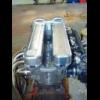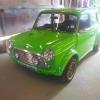Towing A Classic Mini
#1

Posted 03 March 2009 - 08:42 PM
Thinking of buying a A frame for towing my Mini behind my camper van. This will mean I don't need two people, ie one person in the van and the other in the Mini.
Does anyone have experiance of using an A Frame towng device and or using this with a Classic Mini.
Thanks
andrew
#2

Posted 03 March 2009 - 08:50 PM
not sure how true that is
#3

Posted 03 March 2009 - 09:33 PM
although i'm sure there will be loads of people who pipe up saying they use them without problem
#4

Posted 03 March 2009 - 09:41 PM
#5

Posted 03 March 2009 - 09:50 PM
Seems like the A frame is no go and a trailer is the best thing to use.
I got the idea because I've seen motorhomes pulling a SMART car with all four road wheels down and no driver in the towed car. Not sure if they used an A frame or something specific to SMART cars.
anyhow I shall look into a trailer.
Thanks.
Andrew
#6

Posted 03 March 2009 - 10:01 PM
#7

Posted 03 March 2009 - 10:04 PM
Thats a towing dolly.
#8

Posted 03 March 2009 - 10:05 PM
#9

Posted 03 March 2009 - 10:08 PM
dont ask me how it works as i dont no but thats what a lil man who had one told me it did lol
YetI
#10

Posted 03 March 2009 - 10:10 PM
Note on A-Frames and Dollies, issued by the Department for Transport
When an "A" frame is attached to a vehicle (e.g. a motor car) and towed by a motor vehicle (e.g. motorhome) we believe the "A" frame and car become a single unit and as such are classified in legislation as a trailer. As a consequence the car and A-frame are required to meet the technical requirements for trailers when used on the road in Great Britain. These requirements are contained within the Road Vehicles (Construction and Use) Regulations 1986 (SI 1986/1078) as amended (C&U) and the Road Vehicles Lighting Regulations 1989 (SI 1989/1796) as amended (RVLR).
Trailers having a combined axle mass not exceeding 750kg are not required to have brakes fitted. However, if the trailer (regardless of mass) is fitted with a braking system, then all brakes in that system must operate correctly. The regulations do not include design constraints on how this should be achieved but, for example, it could be met by direct linking of the trailer brakes to the brake system of the towing vehicle or by automatic inertia (overrun) operation via the towing hitch. Inertia systems can only be used for trailers with a maximum combined axle mass of 3500kg.
Regulations 15 and 16 set out the braking requirements - including minimum braking efficiencies for trailer brakes. Subject to certain age exemptions, the regulation requires the braking system to comply with the construction, fitting and performance requirements of European Community Directive 71/320/EEC along with its various amending Directives. The most recent consolidated directive is 98/12/EC. Alternatively the braking system can comply with the corresponding UNECE Regulation No.13.09.
In addition, C&U Regulation 18 requires the braking system to be maintained in good and efficient working order. If the brakes of the towing vehicle do not directly operate the trailer brakes the use of an inertia (overrun) system is acceptable. If the trailer braking system has power assistance (i.e. servo or full power) it is likely that this assistance will be required while in motion to meet the required braking efficiencies. This is because once the vacuum reservoir is depleted it is possible that the brakes will not meet the braking efficiency. To prevent the trailer being used illegally a remote vacuum pump, powered from the tow vehicle, could be installed to recharge the reservoir, alternatively a source could be made available from the tow vehicle. From 1 October 1988 the inertia braking system was required to allow the trailer to be reversed by the towing vehicle without imposing a sustained drag and such devices used for this purpose must engage and disengage automatically. This will be very difficult to achieve on an "A" frame using an inertia (overrun) device.
Other provisions from Regulation 15 and Regulation 86A of C&U require the fitting and use of a secondary coupling system in which the trailer is stopped automatically if the main coupling separates whilst the combination is in motion. Alternatively, in the case of trailers up to a maximum mass of 1500kg, the drawbar must be prevented from touching the ground and the trailer able to retain some residual steering.
Whilst being towed, trailers are subject to the relevant requirements given in RVLR, including the use of triangular red reflectors. There would be further requirements for the display of the appropriate number plate, etc.
The use of "dollies" is intended for the recovery of broken down vehicles, not for the transportation of a vehicle from "A" to "B". Under Regulation 83 of C&U a motor car is permitted to tow two trailers when one of them is a towing implement and the other is secured to and either rests on or is suspended from the implement. Therefore as a trailer if the maximum laden weight of the dolly exceeds 750 kg it must be fitted with operational brakes, additionally the brakes on the wheels of the second trailer (the towed car) must work and meet the specified requirements. Again this would be very difficult for the rear brakes of a motor car, on their own, to meet the 50% braking efficiency required for a trailer. The dolly would also be required by Regulation 22 of C&U to be fitted with suspension. Regulations 19 and 22 in C&U permit a broken down vehicle to be recovered without complying with these requirements. However, there is further legislation under the Road Traffic Act that introduces a limitation on the maximum speed that the combination can be driven; this is 40mph on motorways and 20mph on other roads.
#11

Posted 03 March 2009 - 11:10 PM
I got the idea because I've seen motorhomes pulling a SMART car with all four road wheels down and no driver in the towed car. Not sure if they used an A frame or something specific to SMART cars.
As hinted at above when cars are towed behind motorhomes the car is usually specifically conveted to make this legal. Often permanant fixings for an A frame are attached to the car and a servo system is added to the brakes so that they are controlled by the towing vehicle's brakes (by electronic control, not just an over-run brake). The towing vehicle will also take control of the car's rear lighting and the car will be marked with the motorhome's numberplate, also with trailer reflectors and markings to show it is under tow (the length of the combination may require additional lighting such as extra side running lights on the trailer). With all that done, providing the weights are permitted and you are licenced to tow the combination it is legal. The equipment added to the car is permanant making connection of it as a trailer quick and easy but doesn't interfere with normal use of the car when it isn't connected.
Motorhome dealers can provide all the required equipment.
#13

Posted 05 March 2009 - 06:40 PM
Note on A-Frames and Dollies, issued by the Department for Transport
An interesting read. Thanks Jordie (particularly the 40mph!)
#14

Posted 06 March 2009 - 10:22 AM
As long as there is some sort of cable attached to the towed mini to work the brakes should it come adrift from the towing vehicle.
My mate tried to rig up a braking system on his mini but it was too much like hard work so he just used a cable attached to the brakes and pulled them on.
Never had any problems.
1 user(s) are reading this topic
0 members, 1 guests, 0 anonymous users





















